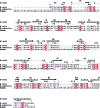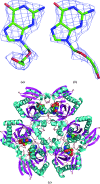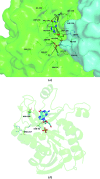Crystal structure of Escherichia coli purine nucleoside phosphorylase complexed with acyclovir
- PMID: 29969103
- PMCID: PMC6038453
- DOI: 10.1107/S2053230X18008087
Crystal structure of Escherichia coli purine nucleoside phosphorylase complexed with acyclovir
Abstract
Escherichia coli purine nucleoside phosphorylase (PNP), which catalyzes the reversible phosphorolysis of purine ribonucleosides, belongs to the family I hexameric PNPs. Owing to their key role in the purine salvage pathway, PNPs are attractive targets for drug design against some pathogens. Acyclovir (ACV) is an acyclic derivative of the PNP substrate guanosine and is used as an antiviral drug for the treatment of some human viral infections. The crystalline complex of E. coli PNP with acyclovir was prepared by co-crystallization in microgravity using counter-diffusion through a gel layer in a capillary. The structure of the E. coli PNP-ACV complex was solved at 2.32 Å resolution using the molecular-replacement method. The ACV molecule is observed in two conformations and sulfate ions were located in both the nucleoside-binding and phosphate-binding pockets of the enzyme. A comparison with the complexes of other hexameric and trimeric PNPs with ACV shows the similarity in acyclovir binding by these enzymes.
Keywords: Escherichia coli; acyclovir; crystal structure; inhibitors; purine nucleoside phosphorylase; structure-based drug design; tumour-directed gene therapy.
Figures




Similar articles
-
Crystal structure of Escherichia coli purine nucleoside phosphorylase in complex with 7-deazahypoxanthine.Acta Crystallogr F Struct Biol Commun. 2018 Jun 1;74(Pt 6):355-362. doi: 10.1107/S2053230X18006337. Epub 2018 May 23. Acta Crystallogr F Struct Biol Commun. 2018. PMID: 29870020 Free PMC article.
-
The crystal structure of Escherichia coli purine nucleoside phosphorylase: a comparison with the human enzyme reveals a conserved topology.Structure. 1997 Oct 15;5(10):1373-83. doi: 10.1016/s0969-2126(97)00287-6. Structure. 1997. PMID: 9351810
-
Crystal structure of the purine nucleoside phosphorylase (PNP) from Cellulomonas sp. and its implication for the mechanism of trimeric PNPs.J Mol Biol. 1999 Dec 17;294(5):1239-55. doi: 10.1006/jmbi.1999.3327. J Mol Biol. 1999. PMID: 10600382
-
Structural analyses reveal two distinct families of nucleoside phosphorylases.Biochem J. 2002 Jan 1;361(Pt 1):1-25. doi: 10.1042/0264-6021:3610001. Biochem J. 2002. PMID: 11743878 Free PMC article. Review.
-
Purine nucleoside phosphorylase: a potential target for the development of drugs to treat T-cell- and apicomplexan parasite-mediated diseases.Curr Drug Targets. 2007 Mar;8(3):413-22. doi: 10.2174/138945007780058997. Curr Drug Targets. 2007. PMID: 17348834 Review.
Cited by
-
Enzymatic Transglycosylation Features in Synthesis of 8-Aza-7-Deazapurine Fleximer Nucleosides by Recombinant E. coli PNP: Synthesis and Structure Determination of Minor Products.Biomolecules. 2024 Jul 4;14(7):798. doi: 10.3390/biom14070798. Biomolecules. 2024. PMID: 39062512 Free PMC article.
References
-
- Bennett, E. M., Anand, R., Allan, P. W., Hassan, A. E. A., Hong, J. S., Levasseur, D. N., McPherson, D. T., Parker, W. B., Secrist, J. A., Sorscher, E. J., Townes, T. M., Waud, W. R. & Ealick, S. E. (2003). Chem. Biol. 10, 1173–1181. - PubMed
-
- Bennett, E. M., Li, C., Allan, P. W., Parker, W. B. & Ealick, S. E. (2003). J. Biol. Chem. 278, 47110–47118. - PubMed
-
- Bzowska, A., Ananiev, A. V., Ramzaeva, N., Alksins, E., Maurins, J. A., Kulikowska, E. & Shugar, D. (1994). Biochem. Pharmacol. 48, 937–947. - PubMed
-
- Caceres, R. A., Timmers, L. F. M. S., Ducati, R. G., da Silva, D. O. N., Basso, L. A., de Azevedo, W. F. Jr & Santos, D. S. (2012). Biochimie, 94, 155–165. - PubMed
Publication types
MeSH terms
Substances
LinkOut - more resources
Full Text Sources
Other Literature Sources
Miscellaneous

